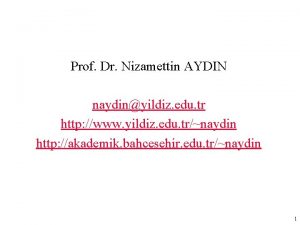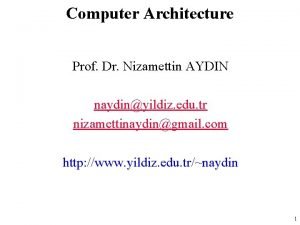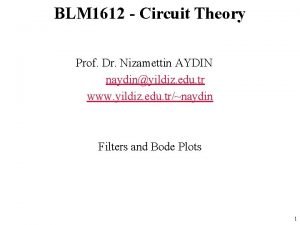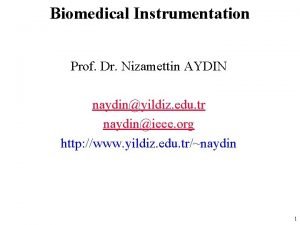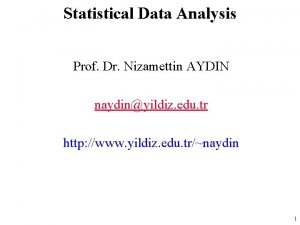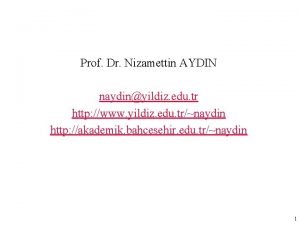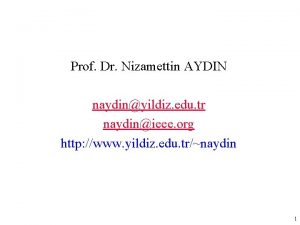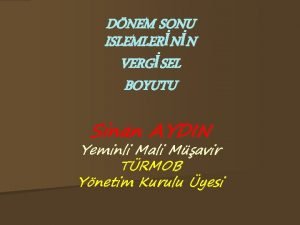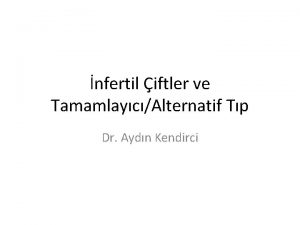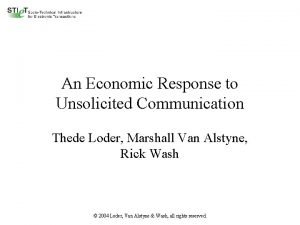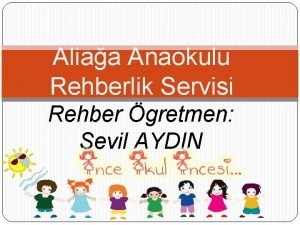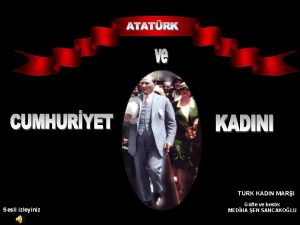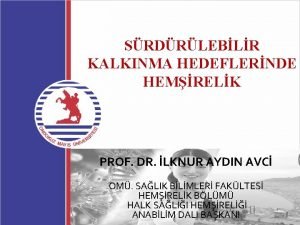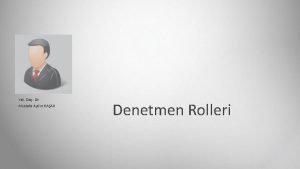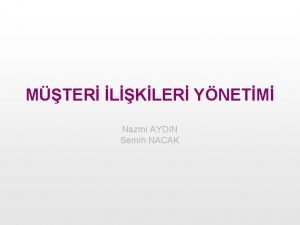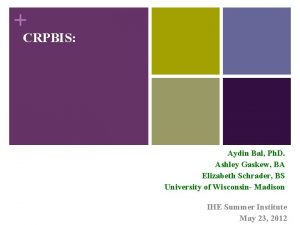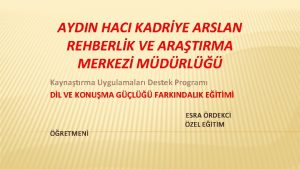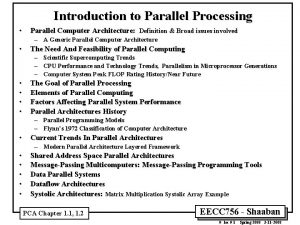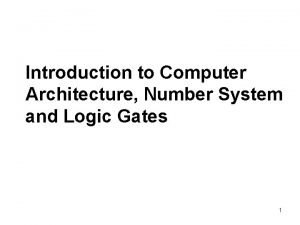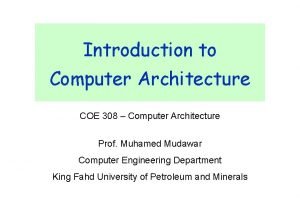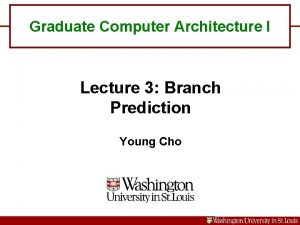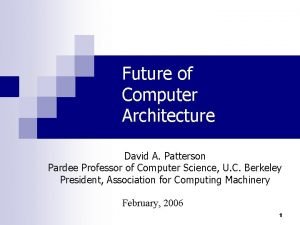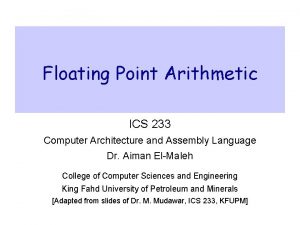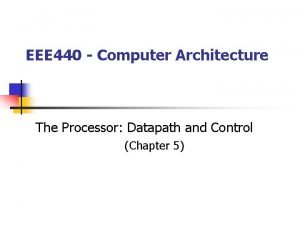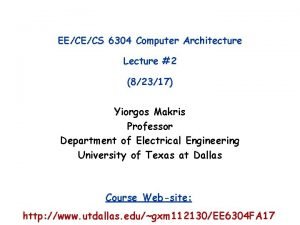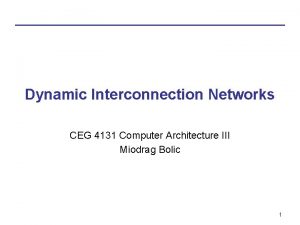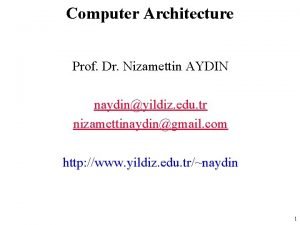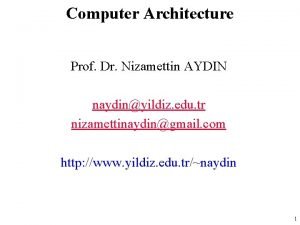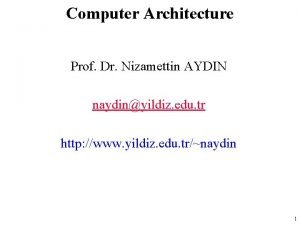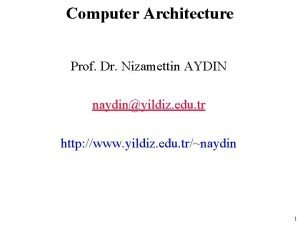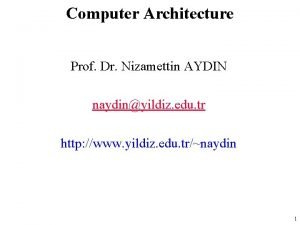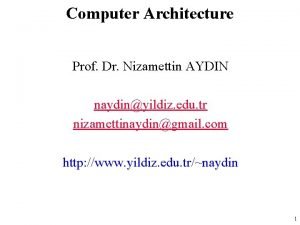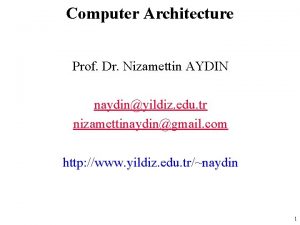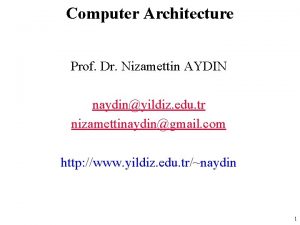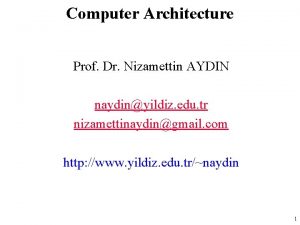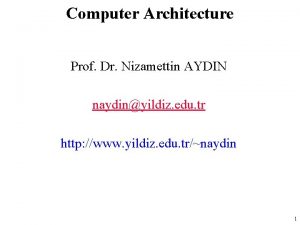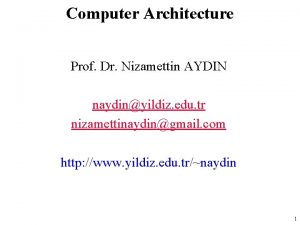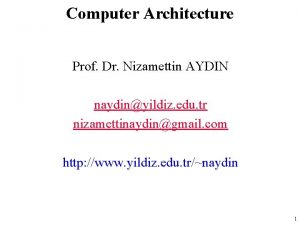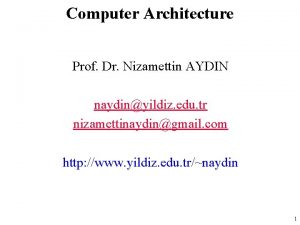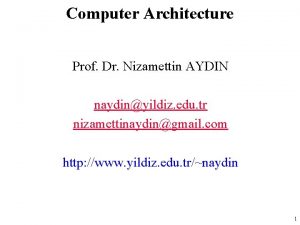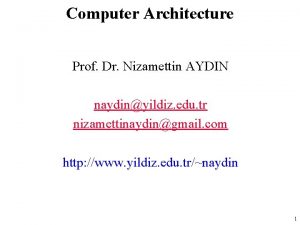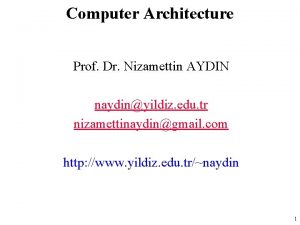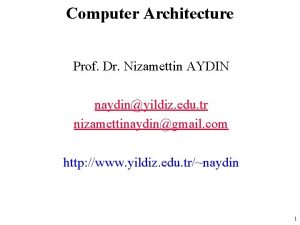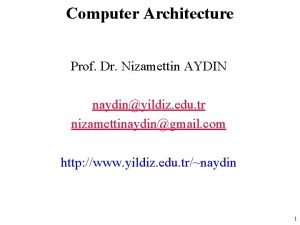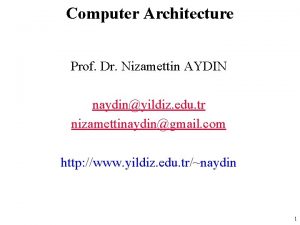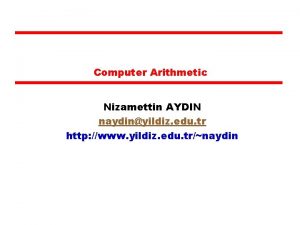Computer Architecture Prof Dr Nizamettin AYDIN naydinyildiz edu



![Levels of Representation temp = v[k]; High Level Language Program v[k] = v[k+1]; v[k+1] Levels of Representation temp = v[k]; High Level Language Program v[k] = v[k+1]; v[k+1]](https://slidetodoc.com/presentation_image_h2/5629fb4a6cf68ffa8b81cfdb6c546661/image-4.jpg)
























































- Slides: 60

Computer Architecture Prof. Dr. Nizamettin AYDIN naydin@yildiz. edu. tr http: //www. yildiz. edu. tr/~naydin 1

Fundamental Computer Elements 2

Fundamental computer elements • Data processing – Provided by gates • Data storage – Provided by memory cells • Data movement – The paths between components are used to move data from/to memory • Control – The paths between components can carry control signals 3
![Levels of Representation temp vk High Level Language Program vk vk1 vk1 Levels of Representation temp = v[k]; High Level Language Program v[k] = v[k+1]; v[k+1]](https://slidetodoc.com/presentation_image_h2/5629fb4a6cf68ffa8b81cfdb6c546661/image-4.jpg)
Levels of Representation temp = v[k]; High Level Language Program v[k] = v[k+1]; v[k+1] = temp; Compiler lw lw sw sw Assembly Language Program Assembler Machine Language Program 0000 1010 1100 0101 1001 1111 0110 1000 1100 0101 1010 0000 $15, $16, $15, 0110 1000 1111 1001 1010 0000 0101 1100 0($2) 4($2) 1111 1000 0110 0101 1100 0000 1010 1000 0110 1001 1111 Machine Interpretation Control Signal Specification ALUOP[0: 3] <= Inst. Reg[9: 11] & MASK ° ° 4

Computer Components-CPU 5

CPU Structure • CPU must: – – – Fetch instructions Interpret instructions Fetch data Process data Write data 6

Registers • CPU must have some working space (temporary storage) – Called registers • Number and function vary between processor designs • One of the major design decisions • Top level of memory hierarchy 7

Registers in the P perform two roles: • User-visible registers – Enable the machine- or assembly language programmer to minimize main memory references by optimizing use of registers • Control and status registers – Used by the control unit to control the operation of the processor and by priviliged, operating system programs to control the execution of programs 8

User Visible Registers • General Purpose registers • Data registers • Address registers • Condition Codes (flags) 9

Condition Code Registers • Sets of individual bits – e. g. result of last operation was zero • Can be read (implicitly) by programs – e. g. Jump if zero • Can not (usually) be set by programs 10

Control & Status Registers • Program Counter (PC) – Contains the address of an instruction to be fetched • Instruction Decoding Register (IR) – Contains the instruction most recently fetched • Memory Address Register (MAR) – Contains the addres of location in memory • Memory Buffer Register (MBR) – Contains a word or data to be written to memory or the word most recently read 11

Program Status Word • A set of bits containing status information • Includes Condition Codes (flags) – Sign • sign of last result – Zero • set when the result is 0 – Carry • set if an operation resulted in a carry (addition) into or borrow (subtraction) out of a high order bit – Equal • set if a logical compare result is equality – Overflow • used to indicate arithmetic overflow – Interrupt enable/disable • used to enable or disable interrupts 12

Example Register Organizations 13

Computer Components-Memory 14

Operation of Memory • Each memory location has a unique address • Address from an instruction is copied to the MAR which finds the location in memory • CPU determines if it is a store or retrieval • Transfer takes place between the MBR and memory – MBR is a two way register 15

Relationship between MAR, MBR and Memory Address Data 16

MAR-MBR Example 17

Visual Analogy of Memory 18

Individual Memory Cell 19

Memory Capacity • Determined by two factors – Number of bits in the MAR • 2 K where K = width of the register in bits – Size of the address portion of the instruction • 4 bits allows 16 locations • 8 bits allows 256 locations • 32 bits allows 4, 294, 967, 296 or 4 GB • Important for performance – Insufficient memory can cause a processor to work at 50% below performance 20

Memory Hierarchy • Registers – In CPU • Internal or Main memory – May include one or more levels of cache – “RAM” • External memory – Backing store 21

Memory Hierarchy • This storage organization can be thought of as a pyramid: 22

Cache • Small amount of fast memory • Sits between normal main memory and CPU • May be located on CPU chip or module 23

Virtual Memory • Cache memory enhances performance by providing faster memory access speed. • Virtual memory enhances performance by providing greater memory capacity, without the expense of adding main memory. • Instead, a portion of a disk drive serves as an extension of main memory. • If a system uses paging, virtual memory partitions main memory into individually managed page frames, that are written (or paged) to disk when they are not immediately needed. 24

RAM: Random Access Memory • DRAM (Dynamic RAM) – Most common, cheap – Volatile: must be refreshed (recharged with power) 1000’s of times each second • SRAM (static RAM) – Faster than DRAM and more expensive than DRAM – Volatile – Frequently small amount used in cache memory for highspeed access used 25

Dynamic RAM Structure 26

Stating RAM Structure 27

Read Only Memory (ROM) • Permanent storage – Nonvolatile • Used in. . . – Microprogramming – Library subroutines – Systems programs (BIOS) – Function tables 28

Types of ROM • Written during manufacture – Very expensive for small runs • Programmable (once) – PROM – Needs special equipment to program • Read “mostly” – Erasable Programmable (EPROM) • Erased by UV – Electrically Erasable (EEPROM) • Takes much longer to write than read – Flash memory • Erase whole memory electrically 29

Types of External Memory • SSD – Fast – Expensive (relatively) • Magnetic Disk – RAID – Removable • Optical – – CD-ROM CD-Recordable (CD-R) CD-R/W DVD • Magnetic Tape 30

Computer Components-I/O 31

Input/Output Problems • Wide variety of peripherals – Delivering different amounts of data – At different speeds – In different formats • All slower than CPU and RAM • Need I/O modules 32

Input/Output Module I/O Module Block Diagram • Interface to CPU and Memory • Interface to one or more peripherals • I/O Module Function: – – – Control & Timing CPU Communication Device Communication Data Buffering Error Detection 33

External Devices External Device Block Diagram • External Devices: – Human readable • Screen, printer, keyboard – Machine readable • Monitoring and control – Communication • Modem • Network Interface Card (NIC) 34

I/O Steps • • • CPU checks I/O module device status I/O module returns status If ready, CPU requests data transfer I/O module gets data from device I/O module transfers data to CPU Variations for output, DMA, etc. 35

I/O Architectures • I/O can be controlled in four general ways: – Programmed I/O • Reserves a register for each I/O device. • Each register is continually polled to detect data arrival. – Interrupt-Driven I/O • Allows the CPU to do other things until I/O is requested. – Direct Memory Access (DMA) • Offloads I/O processing to a special-purpose chip that takes care of the details. – Channel I/O • Uses dedicated I/O processors. 36

Computer Components- Bus 37

Bus • The physical connection that makes it possible to transfer data from one location in the computer system to another • Group of electrical conductors for carrying signals from one location to another • 4 kinds of signals – Data • Alphanumeric • Numerical • instructions – Addresses – Control signals – Power (sometimes) 38

Bus • Connects CPU and Memory • I/O peripherals: on the same bus as CPU/memory or separate bus • Physical packaging commonly called backplane – Also called system bus or external bus – Example of broadcast bus (address bus) – Part of printed circuit board called motherboard that holds CPU and related components 39

Bus Characteristics • Protocol – Documented agreement for communication – Specification that spells out the meaning of each line and each signal on each line • Throughput, i. e. , data transfer rate in bits per second • Data width in bits carried simultaneously 40

Bus types • Data Bus – Carries data – Width is a key determinant of performance • 8, 16, 32, 64 bit • Address bus – Identify the source or destination of data – Bus width determines maximum memory capacity of system • e. g. 8080 has 16 bit address bus giving 64 k address space • Control Bus – Control and timing information • Memory read/write; I/O read/write; Transfer acknowledge; Bus request; Bus grant; Interrupt request; Interrupt acknowledge; Clock; Reset 41

What do buses look like? – Parallel lines on circuit boards – Ribbon cables – Strip connectors on mother boards Physical Realization of Bus Architecture • e. g. PCI – Sets of wires 42

Motherboard • Printed circuit board that holds CPU and related components including backplane 43

44

Typical PC Interconnections Bus interface bridges connect different bus types 45

Instructions • Instruction: – Direction given to a computer – Causes electrical signals to be sent through specific circuits for processing • The operation of the processor is determined by the instructions it executes, – which is referrred as machine instructions or computer instructions • The collection of different instructions that the processor execute is referred as the processor’s instruction set. 46

What is an Instruction Set? • The complete collection of instructions that are understood by a CPU – Machine Code – Binary • Usually represented by assembly codes • Differentiates computer architecture by the – Number of instructions – Complexity of operations performed by individual instructions – Data types supported – Format (layout, fixed vs. variable length) – Use of registers – Addressing (size, modes) 47

Instruction Elements OPCODE Source OPERAND Result OPERAND • Operation code (OPCODE): task – Do this • Source OPERAND reference(s) – To this Addresses • Result OPERAND reference – Put the answer here • Next Instruction Reference – When you have done that, do this. . . 48

Instruction Elements • Source and Result Operands can be in one of the following areas: – Main memory – Virtual memory – Cache – CPU register – I/O device 49

Instruction Format • Machine-specific template that specifies – Length of the op code – Number of operands – Length of operands Simple 32 -bit Instruction Format 50

Instruction Types • Data Transfer (load, store) – Most common, greatest flexibility – Involve memory and registers – What’s a word ? 16? 32? 64 bits? • Arithmetic – Operators + - / * ^ – Integers and floating point • Logical or Boolean – Relational operators: > < = – Boolean operators AND, OR, XOR, NOR, and NOT • Single operand manipulation instructions – Negating, decrementing, incrementing 51

More Instruction Types • Bit manipulation instructions – Flags to test for conditions • • • Shift and rotate Program control Stack instructions Multiple data instructions I/O and machine control 52

Register Shifts and Rotates 53

Program Control Instructions • Program control – Jump and branch – Subroutine call and return 54

Instruction Cycle • Two steps: – Fetch – Execute 55

Fetch Cycle • Program Counter (PC) holds address of next instruction to fetch • Processor fetches instruction from memory location pointed to by PC • Increment PC – Unless told otherwise • Instruction loaded into Instruction Register (IR) • Processor interprets instruction and performs required actions 56

Execute Cycle • Processor-memory – data transfer between CPU and main memory • Processor I/O – Data transfer between CPU and I/O module • Data processing – Some arithmetic or logical operation on data • Control – Alteration of sequence of operations – e. g. jump • Combination of above 57

A simple example – A hypotetical machine 58

A simple example – • Next figure illustrates a partial program execution. • It adds the contents of the memory word at address 940 to the contents of the memory word at address 941 and stores the result in the address 941. • Here 3 instructions (3 fetch and 3 execute cycles) are required 59

Example of Program Execution 60
 Prof. dr. nizamettin aydin
Prof. dr. nizamettin aydin Prof. dr. nizamettin aydin
Prof. dr. nizamettin aydin Prof. dr. nizamettin aydin
Prof. dr. nizamettin aydin Prof. dr. nizamettin aydin
Prof. dr. nizamettin aydin Nizamettin aydin
Nizamettin aydin Package diagram
Package diagram Giga tera
Giga tera Sinan aydın mali müşavir
Sinan aydın mali müşavir Aydın kendirci
Aydın kendirci Unsent message to aydin
Unsent message to aydin Sevil aydın
Sevil aydın Aydın bir türk kadınıyım
Aydın bir türk kadınıyım Dr bushra hasan
Dr bushra hasan Coordination
Coordination Aydin marine
Aydin marine Aydın başar
Aydın başar Nazmi aydın
Nazmi aydın Aydin bal
Aydin bal Aydın kekemelik merkezi
Aydın kekemelik merkezi Buses in computer architecture
Buses in computer architecture Computer architecture and computer organization difference
Computer architecture and computer organization difference Flowchart for memory reference instructions
Flowchart for memory reference instructions Edu.sharif.edu
Edu.sharif.edu Software architecture definition
Software architecture definition Data centered architecture
Data centered architecture Integral vs modular architecture
Integral vs modular architecture Modular vs integral product architecture
Modular vs integral product architecture Computer organization and architecture 10th solution
Computer organization and architecture 10th solution Ocs architecture
Ocs architecture Iit kharagpur virtual lab coa
Iit kharagpur virtual lab coa Introduction to computer organization and architecture
Introduction to computer organization and architecture Timing and control in computer architecture
Timing and control in computer architecture Evolution and interpretation of computer architecture
Evolution and interpretation of computer architecture Dma controller in computer architecture
Dma controller in computer architecture Floating point division algorithm in computer architecture
Floating point division algorithm in computer architecture Lmc addressing modes
Lmc addressing modes Chordal ring
Chordal ring Smt computer architecture
Smt computer architecture Pseudo instructions examples
Pseudo instructions examples 111011-100100
111011-100100 Instruction format in computer architecture
Instruction format in computer architecture Nano control memory
Nano control memory Microprogramming example
Microprogramming example Memory system design
Memory system design Tlb computer architecture
Tlb computer architecture Which pipeline is a linear
Which pipeline is a linear Computer architecture definition
Computer architecture definition Define parallelism in computer architecture
Define parallelism in computer architecture Architect of number system
Architect of number system Computer architecture definition
Computer architecture definition Isa meaning computer
Isa meaning computer Printer is an input device
Printer is an input device Branch prediction
Branch prediction Computer architecture david patterson
Computer architecture david patterson Multiple instruction single data example
Multiple instruction single data example What is guard bit in computer architecture
What is guard bit in computer architecture Daisy chain priority interrupt
Daisy chain priority interrupt Datapath in computer architecture
Datapath in computer architecture Explain virtual memory in computer architecture
Explain virtual memory in computer architecture Computer architecture definition
Computer architecture definition Baseline network in computer architecture
Baseline network in computer architecture
